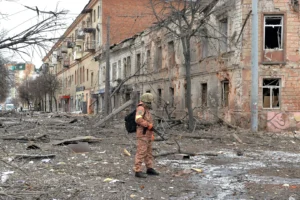The damage from Ukraine’s first-ever strike with American-supplied M39 missiles, targeting a pair of helicopter bases in Russian-occupied southern and eastern Ukraine, likely resulted in greater damage than even the Ukrainian defense ministry initially claimed.
Far greater.
The Ukrainians claimed the Oct. 17 attack, which reportedly saw three of the M39s strike airfields outside Berdyansk in southern Ukraine as well as in Luhansk Oblast in the east, destroyed nine Russian helicopters.
In fact, the M39 raid put out of action 21 helicopters, according to an analysis of commercial satellite imagery by GeoConfirmed, an open-source intelligence practitioner on the social-media site formerly known as Twitter.
“This is probably the biggest blow to the Russian air force since the beginning of the war,” GeoConfirmed commented.
A second analysis, by Ukrainian analysis team Frontelligence Insight, aligns with GeoConfirmed’s assessment. “While their number slightly exceeds our team’s public estimate, it’s important to note that their estimate is based on solid grounds.”
To confirm a destroyed or significantly damaged helicopter, the analysts looked for satellite imagery depicting scorch marks around the known recent location of a parked helicopter. They cross-referenced the overhead imagery with photos and videos from Russian social media—and also looked for evidence of the Russians hauling away, from either airfield, damaged and unflyable helicopters.
Some observers have questioned the analysts’ tallies. “The challenge arises from the limitations of commercially available imagery, which do not provide the resolution needed to detect hundreds of small scorch marks around helicopters in Berdyansk,” Frontelligence Insight conceded. “In the case of Luhansk airport, it’s much easier since you can clearly see it from our higher-resolution imagery.”
And GeoConfirmed stressed that its count, while perhaps shockingly high, is consistent with the destructive power of the M39 missile.
The M39 Army Tactical Missile System, or ATACMS, is a two-ton, 13-foot ballistic missile with a solid rocket motor and a warhead containing 950 Msubmunitions. Fired by a tracked or wheeled launcher, the 1990s-vintage missile ranges as far as 100 miles under inertial guidance.
An M39 usually should strike within 50 yards or so of its aim-point. This isn’t super-accurate by modern standards, but it’s accurate enough considering that the M39 is an area weapon.
As the missile plummets toward its target, it spins and pops open, scattering 950 steel-and-tungsten bomblets across an area of potentially tens of thousands of square feet. Each M74 submunition has the explosive power of a hand grenade.
A submunition warhead is perfect for striking large installations crowded with unprotected equipment. An airfield, for example, with its fragile airplanes, helicopters, fuel bowsers and support equipment.
It’s not for no reason that, when it tested the M39, the U.S. Army aimed the missile at a mock airfield where the service parked old helicopters and trucks. Footage of the test depicts submunitions tearing into the vehicles.
Accurately aim an M39 at an airfield the size of the one outside Berdyansk, and you’ll sprinkle submunitions across half of it. “This whole airfield is covered with little holes,” GeoConfirmed explained.
The Russians flew dozens of helicopters from Berdyansk alone: it’s possible most of them were on the ground as the bomblets rained down. That’s why GeoConfirmed and Frontelligence Insight were comfortable standing by their new, much higher tallies of Russian losses from the Oct. 17 raids.
The M39, when used as the Americans intend, is perfect for wrecking helicopters. And the Russians offered the Ukrainians ideal targets: two airfields fewer than a hundred miles from the front line, and packed with rotorcraft.
Source : Forbes











